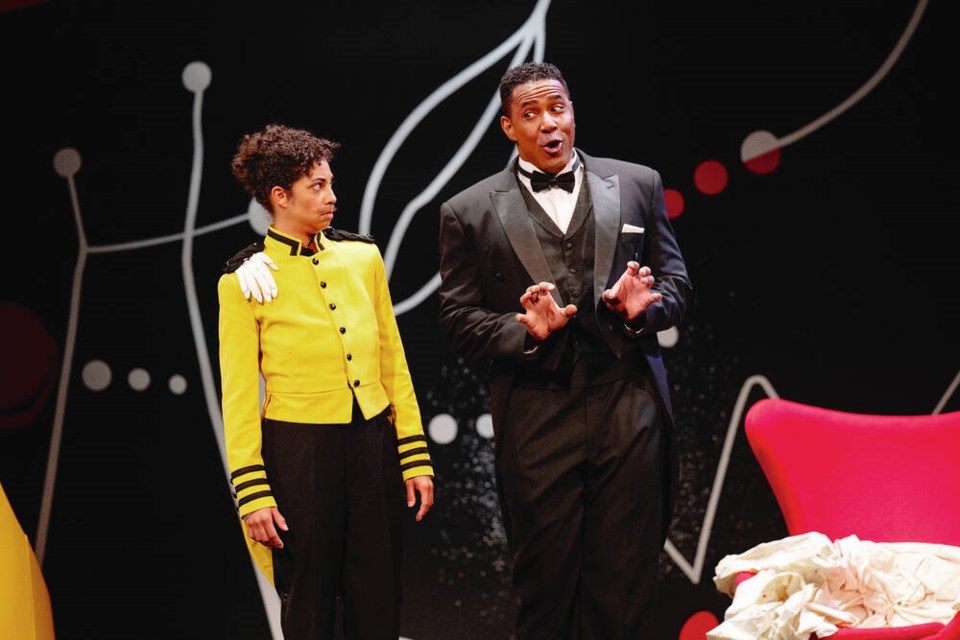Pacific Opera Victoria’s The Marriage of Figaro boasts a design concept that’s very bold indeed.
Mozart’s opera buffa — among the most popular in the repertoire — is originally set in a Spanish chateau during the 18th century. Canadian designer Ken McDonald has said “fie on that,” opting instead for a wild Fellini-esque fantasy that takes a minute or two to get used to.
The audience is greeted by giant sculptural set pieces that might have been crowbarred from Joan Miro’s greatest canvases. These vast, organic structures are decorated with the sort of whimsical, surrealistic shapes that made the Spanish artist a towering titan of 20th-century art.
An atomic-age aesthetic endeavours to whisk this Marriage of Figaro from fusty tradition to retro-cool grooviness. Figaro’s fiancé Susanna boasts a B-52 hairstyle; meanwhile, Countess Almaviva rocks a cool beehive of her own. Singers cavort around an Arne Jacobsen egg chair. And Cherubino the page prances about in the kind of canary-yellow bellhop uniform you’d see in a Wes Anderson flick.
Exactly what all of this has to do with the plot may be a head-scratcher for some. No doubt a few traditionalists will moan — still, I found it all to be great fun.
The Marriage of Figaro is one of Mozart’s supreme achievements. The melodies are divine, the orchestration is unrelentingly witty and nuanced. There’s a seemingly endless cavalcade of “Oh-I-know-that-one” opera hits. The characters are surprisingly three-dimensional — it’s like we’re watching actual people grappling with real-life dilemmas.
This is a farce to end all farces. Figaro, a lowly valet, is engaged to Susanna, a lowly maid. But there’s a spanner in the works: Count Almaviva intends to take advantage of “droit du seigneur,” a feudal rule allowing an aristocrat to have sex with a servant girl on her wedding night.
What follows are shenanigans galore — a byzantine maze of trickery, disguise and plenty of hiding behind beds, chair and doors. It’s pure frothy fun, like taking a bubble bath with a glass of pink champagne.
(That said, the comedy is binded by a thread of serious political commentary. The Marriage of Figaro is based on a 1784 Beaumarchais play portraying servants revolting against their masters, a subject matter dangerously controversial at the time.) On Wednesday night Victoria Symphony musicians, conducted by Timothy Vernon, bobbed their heads during the famous overture, dispatched with spritely vivacity. Figaro (bass-baritone Donovan Singletary) entered to measure off the wedding chamber, happy in his work until Susanna (soprano Suzanne Rigden) reveals this is the room where the count (baritone Tyler Duncan) intends to bed her.
In this scene the orchestra — while not overly loud — dominated the mix. It seemed the singers (both here and, at times, elsewhere) might have projected more.
A pair of comic characters almost stole the show. Soprano Cecile Muhire did a lovely job as Cherubino, an adolescent Puck intent on copulating with any female in sight. Managing a little backwards somersault upon entering, Muhire gave a fine rendition of Non so piu cosa son, in which the character details his randy aspirations. Overall, hers was a fine, fully realized performance — charming and highly physical.
Although the role Dr. Bartolo — a Malvolio-style fool — is much smaller, bass-baritone Peter McGillivray gave larger-than-life performance. Clownishly bespectacled, McGillivray, like Muhire, displayed a canny knack for physicality, at one point angrily giving Figaro’s hairbrush a savage scissoring before stabbing it.
Such attention to detail typifies the directorial approach. Morris Panych, a noted Canadian playwright and director, strikes a fine balance — making The Marriage of Figaro entertainingly broad while not overdoing it. There’s lots of complex stage business, all navigated with wit and stylish panache.
Lead roles are solidly sung. Each principal had fine moments: whether it was Rigden (Susanna) nailing a dizzying high note in Deh vieni non tardar, Duncan (the count) delivering a robust Vedro mentr’io sospiro (Must I forgo my pleasure) or Singletary (Figaro) teasing Cherubino about his impending military conscription with Non piu andrai.
No one sang better than soprano Sydney Baedke. Countess Almaviva is an oddly two-dimensional being, practically a martyr figure, hopelessly devoted to her husband despite his infidelities. Baedke made the character otherworldly, almost heavenly, giving The Marriage of Figaro a sense of pathos luminating the earthly rabble-rousing down below.
The all-too-brief Porgi amor, during which the countess longs for her husband’s affections, was notable for the singer’s exquisite legato phrasing. Immediately we realize this was a singer to be reckoned with. The famous Dove Sono was equally impressive, with Baedke revealing a sweet, pure voice that projected thrillingly.
Worth seeking out, The Marriage of Figaro continues at the Royal Theatre tonight as well as April 7 and 9.



